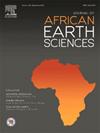High-resolution sequence stratigraphy and microfacies analysis of the lower part of the Sa'di Formation in selected wells from the West Qurna oilfield, southern Iraq
IF 2.2
4区 地球科学
Q2 GEOSCIENCES, MULTIDISCIPLINARY
引用次数: 0
Abstract
Tectonic and eustatic changes have had major impacts on the Cretaceous stratigraphy and its hydrocarbon potential in southern Iraq, and the Sa'di Formation is one of several Cretaceous carbonate plays that reflect these types of changes. To further examine the influence of these impacts, thin sections from cores, as well as wireline and image logs, from the lower part of the Sa'di Formation in four wells from the West Qurna Oilfield were examined. Wackestone, packstone, grainstone and floatstone microfacies groups were identified and subdivided into ten submicrofacies. The microfacies were deposited at several environments such as open marine, restricted and outer ramp, as well as to position in transgressive and highstand sequence tracts in two fourth-order parasequences. Moreover, microfacies were compared with Formation Microresistivity image (FMI) logs and show that image logs can be used to recognize microfacies and their likely environments. Integration of these analyses with paleogeography and regional tectonics suggests that the lower Sa'di Formation reflects early deposition in a newly formed foreland basin that represents ongoing subsidence accompanying collision and closure of the Neo-Tethys Ocean. The carbonate-rich nature of the unit is linked to deposition on the distal margin of the foreland basin in an arid climate, while cyclicity in the unit represents both tectonic and eustatic fluctuations.
求助全文
约1分钟内获得全文
求助全文
来源期刊

Journal of African Earth Sciences
地学-地球科学综合
CiteScore
4.70
自引率
4.30%
发文量
240
审稿时长
12 months
期刊介绍:
The Journal of African Earth Sciences sees itself as the prime geological journal for all aspects of the Earth Sciences about the African plate. Papers dealing with peripheral areas are welcome if they demonstrate a tight link with Africa.
The Journal publishes high quality, peer-reviewed scientific papers. It is devoted primarily to research papers but short communications relating to new developments of broad interest, reviews and book reviews will also be considered. Papers must have international appeal and should present work of more regional than local significance and dealing with well identified and justified scientific questions. Specialised technical papers, analytical or exploration reports must be avoided. Papers on applied geology should preferably be linked to such core disciplines and must be addressed to a more general geoscientific audience.
 求助内容:
求助内容: 应助结果提醒方式:
应助结果提醒方式:


